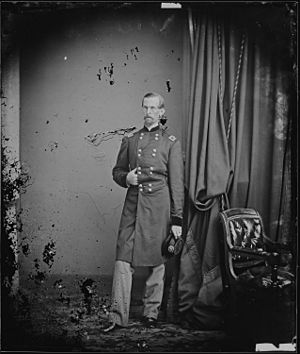Jeremiah C. Sullivan facts for kids
Quick facts for kids
Jeremiah Cutler Sullivan
|
|
|---|---|

Photograph of Brigadier General Jeremiah C. Sullivan
|
|
| Born | October 1, 1830 Madison, Indiana |
| Died | October 21, 1890 (aged 60) Oakland, California |
| Place of burial |
Mountain View Cemetery,
Oakland, California |
| Allegiance | Union |
| Service/ |
|
| Years of service | 1848–1854 (Navy) 1861–1865 (Army) |
| Rank | |
| Unit | 6th Indiana Infantry Regiment |
| Commands held | 13th Indiana Infantry Regiment 2nd Brigade, 3rd Division, Army of the Mississippi District of Jackson, Tennessee 2nd Division, Army of the Shenandoah |
| Battles/wars | Mexican–American War American Civil War |
Jeremiah Cutler Sullivan (born October 1, 1830 – died October 21, 1890) was an important person from Indiana. He was a lawyer, an officer in the United States Navy before the American Civil War, and a high-ranking general in the Union Army during the war. He was one of the few former Navy officers who became infantry generals during the war.
Early Life and Career
Jeremiah C. Sullivan was born in Madison, Indiana. His father, also named Jeremiah Sullivan, was a lawyer from Virginia. His father served as a judge on the Indiana Supreme Court. He even came up with the name "Indianapolis" for Indiana's new capital city. Jeremiah C. Sullivan's older brother, Algernon Sydney Sullivan, became a famous lawyer in New York. He founded the law firm Sullivan & Cromwell.
Sullivan joined the United States Naval Academy in Annapolis, Maryland, and finished his studies in 1848. He became a midshipman, which is a junior officer. For the next six years, he spent most of his time at sea. He served on four different ships and even took part in the Mexican–American War. In April 1854, he left the Navy and went back home to Indiana. There, he studied law, passed his exams, and started his own law practice.
Serving in the Civil War
When the Civil War began, Sullivan helped gather and organize a group of soldiers. This group was the 6th Indiana Volunteers, an infantry regiment. He was chosen as a Captain and led his troops into their first battle at Philippi in western Virginia. After his first term of service ended, Sullivan left the army.
However, he soon received a new role from Governor Oliver P. Morton. He became a Colonel and was put in charge of the 13th Indiana, a regiment that would serve for three years. Sullivan returned to western Virginia with the army of George B. McClellan. He fought in battles at Rich Mountain and Cheat Mountain in the summer of 1861.
In the spring of 1862, Sullivan led an infantry brigade during the Valley Campaign. He guided his soldiers into battle at the First Battle of Kernstown. He was promoted to brigadier general on April 28, 1862. Later that spring, he moved to the Western Theater of the war. There, he commanded a brigade in the Army of the Mississippi under William S. Rosecrans. Sullivan fought again in the battles of Iuka and Corinth in Mississippi.
In the fall of 1862, Sullivan was given command of the District of Jackson, Tennessee. This area had many scattered Union troops. His soldiers often faced attacks from Confederate general Nathan B. Forrest. One notable fight was the Battle of Parker's Crossroads on December 31, 1862.
In late December, Sullivan received a controversial order from General Grant. This order, called General Order #11, was issued on December 17, 1862. It called for the removal of a specific group of people from his military district. Sullivan initially refused to carry out the order. He believed his duty was to the army, not to enforce such a directive. However, four days later, he was forced to follow the order. Luckily, Abraham Lincoln quickly canceled Grant's General Order on January 4, 1863.
During the 1863 Vicksburg Campaign, Sullivan worked closely with Maj. Gen. Ulysses S. Grant. He served as the acting inspector general for Grant's army. After Vicksburg surrendered on July 4, Sullivan became the Chief of Staff for Maj. Gen. James B. McPherson. In September, he was moved to the Department of West Virginia. There, he served under his father-in-law, Maj. Gen. Benjamin F. Kelley. Sullivan was given command of a division. His job was to protect the very important Baltimore and Ohio Railroad in Western Maryland. In mid-October 1863, he led his troops from Harpers Ferry. They stopped an attack on Charleston, West Virginia, by Confederates led by John D. Imboden. Sullivan's forces pushed the enemy back up the valley.
During the Valley Campaigns of 1864, Sullivan's commander, David Hunter, became unhappy with him. Hunter felt Sullivan was not taking enough action. Because of this, Sullivan was replaced by Brig. Gen. George Crook on July 16. After this, Sullivan was never given a major command again. He left the army on May 11, 1865. It is interesting to note that he was not among the many Union generals who received special promotions to higher ranks when the war ended.
Life After the War
After the Civil War, Sullivan moved to Oakland, Maryland. Later, in 1878, he traveled west to California. Even though he had been trained as a lawyer, he worked in various simple office jobs in both states.
Jeremiah C. Sullivan passed away in Oakland, California, in the fall of 1890. He died shortly after his sixtieth birthday. He is buried in Mountain View Cemetery in Oakland.

